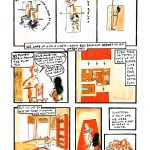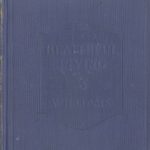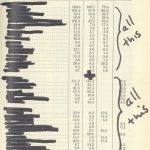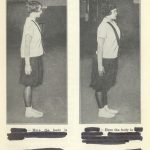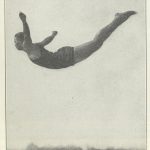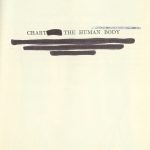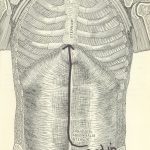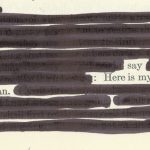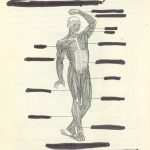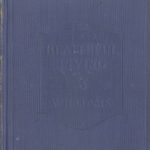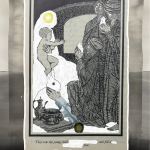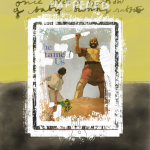

Abigail Chabitnoy is a mixed-race (German-Aleutian) poet raised in Pennsylvania and currently living in Colorado. Her first collection of poetry, How to Dress a Fish, was released in 2019 by Wesleyan University Press and is described as a “historical reclamation” in which “the speaker … works her way back, both chronologically and spatially toward a place that once was home” (see Weston Morrow’s review in Blackbird).
Chabitnoy has been previously published in Pleides, Boston Review, Gulf Coast, Hayden’s Ferry Review, Tin House, and elsewhere. She was a Crow-Tremblay Fellow at and received the John Clark Pratt Citizenship Award from Colorado State University, and she was a 2016 inaugural Peripheral Poets Fellow.
Former Florida Review contributor John Sibley Williams interviewed her for us in the fall of 2019.
John Sibley Williams for The Florida Review:
“Everyone wants to see ghosts, in theory.” This line resonates across your entire collection. In a way, it defines your approach to storytelling. Tell me what this line means to you.
Abigail Chabitnoy:
It’s interesting that you’ve honed in on this line, as this was a later addition—and also one that does continue to haunt or inform much of my current thinking as well. At the most fundamental level, I’ve always been a bit of a wimp when it comes to horror. I’m fascinated by the idea of ghosts and the paranormal, but for an example, this past February I was a resident at Caldera in eastern Oregon. Midway through the residency one of the other artists asked the Programs Manager if any of our cabins were haunted, and I would not let her answer. I would not have been able to sleep in my cabin by myself, or leave that cabin after dark, if I knew there were ghosts on the premises—and to be honest, I don’t even know if I believe in ghosts. I was never allowed to play with Ouija boards or anything that could be considered occult growing up, which means I’m deeply uncomfortable with forces beyond my control and also that I’ve never properly unpacked my relationship with such forces. I don’t know if the other artists ever got to hear the answer when I wasn’t present, and in this context the example and line are quite benign. But consider the ramifications of such an unwillingness to face real horrors in this world, or real atrocities in history, or inconvenient truths that don’t prop up the narrative we want. See no evil, right no evil. The well-meaning narrative that we are a country founded by immigrants, for example, on the one hand encourages xenophobes to revisit the ghosts of their own past and their own relationship to this country, but further fails to face the violent genocide that cleared way for the first colonizers and earliest immigrants.
In terms narrower to the work, it’s a reminder of my own culpability in putting forth some stories and not others, and my responsibility to be faithful to my family’s narrative even when it doesn’t support the kind of rage or righteous anger one might desire for effect. My great-grandfather was removed impossibly far from his home, and it would have been incredibly hard for him to return. But the truth is: we simply don’t know if he even wanted to. Relationships were severed, but who’s to say they would have survived either way?
TFR:
I’ve found indigenous poetry often dually emphasizes place and placelessness, cultures thriving yet irrevocably changed by outside influences. Do you feel this is an accurate statement? Is it emotionally demanding to write from such a place?
Chabitnoy:
I can only say that this statement feels particularly accurate for my own work, and that’s because of how place and the removal from a specific place have shaped my family’s and my own experience of indigeneity. I’ve been fortunate that in tandem with my own searching for ways to reconnect meaningfully with my Unangan and Sugpiaq heritage, there have been various localized efforts by those communities to also revitalize the culture, to promote language acquisition and recover traditional art practices, and to take control of their own narrative, which has provided me with rich resources I can access remotely and has put me in touch with wonderful and enthusiastic people to patiently answer my questions, as the cost of going home is prohibitive (in more ways than one). I grew up with so many of the pieces missing that each one remains significant—including absence. And yet despite this absence, I do carry this visceral memory of home with me. I’ve always lived landlocked (first in Pennsylvania, now in Colorado) and yet as an anxious individual, there is a calm that takes hold when I am by the water that I am unable to find anywhere else. I find it extremely demanding to write from such a place personally, and the complexities I’ve just scratched the surface of here almost stopped me from sending the work out into the world more than once. It demands almost a constant othering of the self, a repeated rupturing, but then also a turning back toward a personal reparations of sort, some kind of healing.
TFR:
Your poems slide so organically between the tangible and ephemeral, body and legend, past and present. These elements all exist in the same sphere. For you, where does mythology end and contemporary human life begin? Is there a demarcation line? How do they inform each other?
Chabitnoy:
The boundaries of myth are still something I question and push against daily. I loved reading myths and folktales as a kid. In fact, it’s one of the few things I distinctly remember reading. It inspired me to get my BA in anthropology. (I was a latecomer to poetry, and it was in fact Anne Carson’s Autobiography of Red, itself building on the Greek myth of Geryon, that won me over.) I’ve been thinking a lot lately of what the purpose of myth is, what it is stories do, and why we keep telling them, and the closest thing to a working answer I’ve come to so far is that stories are necessary to help us survive. They teach us, they connect us, they present possibilities we at once might never have considered and that are timeless at their roots. There’s so much crossover in the motifs across time and culture, which I find fascinating. But it’s also interesting to me that they’re always perceived in the past tense, similarly to how society still often expects Native cultures to continue in a vacuum, forever frozen as they were first encountered by [white] settlers. But to be timeless means to look both ways, forward and back. I think I see this blurring of the demarcation as a way of extending beyond the self and beyond the present moment to tap into something bigger, something more fluid.
TFR:
Is there empowerment in (finally) being able to tell your own story, in your own words, from your own cultural and personal perspective?
Chabitnoy:
I think I have found empowerment in the process of writing this book, but I’m not sure if in this way. Which is to say, I think the experience has made me truly recognize the breadth of stories and perspectives, to recognize the microaggressions that potentially—and sometimes actually—prevent those narratives from being told, and to push past those aggressions even as I recognize and sympathize with where they are coming from. But I also think the work has taught me to accept that there aren’t always answers, and to allow me to continue in the space of that uncertainty. Poetry isn’t necessarily about finding the answers—it’s about learning to ask the right questions, the hard questions. And it’s okay to dwell in that space of uncertainty.
TFR:
How to Dress a Fish paints a multifaceted portrait of betweenness. As a child of mixed heritage, you seem to question your prescribed place in both communities. Yet you celebrate them. How does communal and familial belonging (or their lack) impact your poetic vision?
Chabitnoy:
Despite my family and my mom’s family being somewhat large, it didn’t feel like I grew up in a large family. Our extended family seldom came together, and my family doesn’t really tell stories. I think perhaps that’s why I cling so tightly to my great-grandfather’s story, fragmented as it is. I think much of my poetic vision is driven by a desire for community, and I don’t think this is particular to one side so much as a reflection of the isolation frequently experienced in today’s society. I think that particular desire drives much of the thematic elements and motivations within the poems, but for me there is personally also a pressure on the work to generate a greater sense of community outside of the book as well. In 2018, I finally made it to Kodiak, and as beautiful as the island was, and as moving as it was to stand on the beach of Woody Island, to be on that water, to feel home, my favorite experience was visits I had with cousins whom I’d never met nor even been aware of (and still couldn’t articulate clearly the direct lines of our relation), and how easy and grounding it was to spend hours talking to these women, hearing their stories, what they knew of our family. It was a wonderfully peaceful experience of belonging, as natural as a fish in the water, and the forging of these relationships in turn puts further pressure on my work to be sincere and rigorous in its research and its motives.
TFR:
Tell me what you mean by “legacy as a blank space. A space that unlike a slate cannot be written.”
Chabitnoy:
This language was actually in response to a narrative I read about one student’s experience of the Carlisle Indian School, but also became emblematic of the larger challenges of responding to past trauma. In my own experience, there are questions I have of my ancestors that simply will never be answered. There are voices I can’t speak for, and to attempt to would be a disservice, another form of erasure. Rather than attempting to fill these blank spaces, these holes and wounds, I have attempted to leave space for them to be felt in their own right throughout the work. The slate also refers to the sociological notion of the child’s mind as a blank slate, further emphasizing the rupture and inheritance of these holes we carry with us as survivors and descendants of historical trauma.
TFR:
When discussing culturally significant themes that you have such strong feelings on, how do you express your worldview subtly, avoiding didacticism? How do you make a point without preaching?
Chabitnoy:
This has actually been (and continues to be) a constant subject of attention personally since I first began writing seriously. With this work in particular, I employed several techniques to avoid didacticism. One “cheat” I used was ultimately to use the problematic language of others directly in the work and let their prejudices speak for themselves. Another way I avoided this in the writing was in my approach to audience. Many of the poems were approached as conversations I imagined having, most often with Michael, or at least Michael as the character I tried to summon to the pages. But as the project unfolded, that individual became multiple, became fluid. Sometimes I imagined I was talking to the grandfathers I had never known, but that could become a bit intimidating, perhaps because I never had a grandfather figure, and because of the weight I gave these figures. So I tried to imagine a more approachable figure, a sympathetic figure. I began to think of Nikifor, I suppose as the character with the least narrative developed and thus the most space for potential, but also because it was brought to my attention that the women in the book were missing, and it was true, but—beyond an imagined address—I didn’t know how to bring them to the page. There was even less of them in the archives. I think this is where the more mythopoeic themes come into play as well, which further gave me room for more imaginative work that could create distance from more didactic trains of thought.
TFR:
Now that indigenous peoples have the chance to tell their own stories, unfiltered by “white men with pipes and elbow patches who study Natives from armchairs,” do you feel a sense of responsibility to set history straight? How does one go about rewriting a disingenuous legacy?
Chabitnoy:
I think poetry is a brilliant avenue for indigenous people to tell their own stories, and in their own ways and structures. But for me, I feel a personal responsibility to remain within the conversation of my own family’s story and experience, and beyond that to give as much voice as I can to the history of my ancestors in the Aleutian islands while also recognizing the limits of my own understanding given the circumstances of my dislocation. I think the attention to language inherent to poetry makes it a good medium in which to question, for example, historical and anthropological narratives written by outsiders. What some historians call a strategic military victory, for example, are otherwise experienced as genocide. But I also feel a responsibility not to extend myself beyond the honest reach of my own understanding, experience, and voice. That is, I am more aware of my responsibility not to claim to speak for others, or to speak in a generalized manner, to recognize the gaps in my own knowledge and turn instead to the voices of other indigenous writers to extend the scope of my understanding rather than purport to know more than I do.
TFR:
As you employ a variety of formal and remarkably unique styles throughout How to Dress a Fish, how do you decide which structure will best serve a given poem? Is it intuition, poetic experimentation, or an intentional choice? And what motivates these structures?
Chabitnoy:
I think a lot of it comes down to intuition and experimentation, which in turn generate their own sort of internal rules that develop throughout the work. A lot of it has to do with the feeling of the shape on the page. For example, the narrative is messy. It’s full of holes. It’s nonlinear. It interrupts itself. It sometimes promises order (the few that include numbered parts), but ultimately denies any order. Thus for the poems to neatly hug the left margin or exist in tidy couplets or even stanzas felt ungenuine to how the narrative is experienced. With that said, there are also elements that line up, lines that may break but continue to meet. And of course ultimately these are water poems, and so it’s right that they should—like a fleet of kayaks, an archipelago, or even wreckage that washes up on shore—drift across the white space of the page.
TFR:
Speaking of structures, you often use objective “non-poetic” forms like student records, grocery lists, and footnotes to explore your themes. What draws you to poeticizing these forms? What do you feel they add to the book’s ongoing conversation?
Chabitnoy:
One of the things I love about poetry is its capacity for accumulation, to hold multitudes. I was drawn to a kind of docu-poetics because of how it could potentially make this process of accumulation apparent. In some cases, I wanted to challenge the credentials of such forms and the contexts in which they are most frequently used. Footnotes, for example, are often used in scholarly texts and lend academic authority, an air of certainty, to a body of work. My family’s enrollment into the Koniag Corporation and my sister’s and my subsequent acceptance into the Tangirnak Native Village depended on Michael’s student records and birth certificates. The case for the “success” of the Carlisle Indian School rested on surveys and news clips, the release of which and survival in the record depended on their favorable reflection on the school. Such documents are given a weight of authority that other modes of record keeping—oral histories, for example—are not. I wanted to open those structures to the same kind of skepticism traditional knowledge and oral histories are frequently subject to, while also asserting that same level of respect for such narratives. The use of grocery lists meanwhile was an effort to bring the daily into the historical narrative, to highlight the confluence of the two.
TFR:
Let’s talk erasure for a moment. Sometimes you cross words out, which allows us to see what you chose to expunge. Other times you blacken words out, making them unreadable. What roles do these forms of erasure play in your poems? Do you feel erasure is inherently a part of exploring a misrepresented culture?
Chabitnoy:
Erasure has certainly been a large part of my experience, yes. And there are various reasons, from negligence to willful erasure to sudden deaths in the family. But also at the root of these erasures is a discrepancy in which narratives get valued, whose, what information is deemed at the moment worthy of preserving. And it’s not just the narratives that get erased. Sometimes the story is preserved but the storyteller is erased and credit given to the note-taker or “scholar.” And then sometimes there is a desire to remain anonymous, or a desire as note-taker to preserve the privacy of an individual. All of these possibilities play into what I’ve chosen to erase entirely and what I’ve chosen to leave legible even while I suggest that someone else might choose to erase that text, might deem it unworthy of recording. For me, such markings became another way of subverting traditional hierarchies of authority and knowledge and highlight the lack of transparency in the recordkeeping and writing of history. Additionally, one of the operative themes of the work is that our understanding of our history is a process, is not fixed in stone, is subject to scratch-outs and do-overs, to misspeaking and self-correction, which I somewhat approached in those words that were only crossed out as one might when drafting with paper and pen.
TFR:
I know this is a broad question, but what are your thoughts on the current state of indigenous poetry? What other authors would you recommend? And where would you like to see it in, say, ten years?
Chabitnoy:
I’m very excited about the current state of indigenous poetry. Of course the representation and recognition could always be greater in the various categories of accolades and outside of academic circles of discussion. But if your finger is on the pulse of indigenous writing these days, there are so many great writers to follow, and some really great new voices emerging. Layli Long Soldier’s Whereas came out in 2017 and garnered quite a bit of attention. Sherwin Bitsui just released a new book, Dissolve. And of course Heid Erdrich just released a great new anthology, New Poets of Native Nations. Craig Santos Perez, Allison Adelle Hedge Coke, and Brandi Nālani McDougall also recently released an anthology of indigenous poetry by Pacific Islander women, Effigies III. In 2018 I had the privilege of reading along with several indigenous women in Seattle to celebrate the launch of Carrie Ayagaduk Ojanen’s debut collection, Roughly for the North, and also had the pleasure of hearing Cassandra Lopez’s work for the first time. Her book Brother Bullet was just published. I went to an amazing panel on Indigenous Womanisms where I heard work by No’u Revilla and cannot wait for more of it to be available. She was stunning. She’s one of the women featured in Effigies III. This list could go on forever. And, of course, I’d still leave people out.
Ten years is such a long time. I wasn’t even seriously engaging with poetry ten years ago. I hope the field continues to grow, in terms of writers but also in the breadth of style and subject, as it is currently. But maybe also it would be nice to see wider recognition of more than just one writer per genre at a time. It seems that outside of the indigenous poetry community, in more mainstream consciousness, there is always one Native fiction writer, one Native memoirist, one Native poet that everyone knows, almost like a box to check off and then move on, when in fact there are so many writers to be excited about right now.




